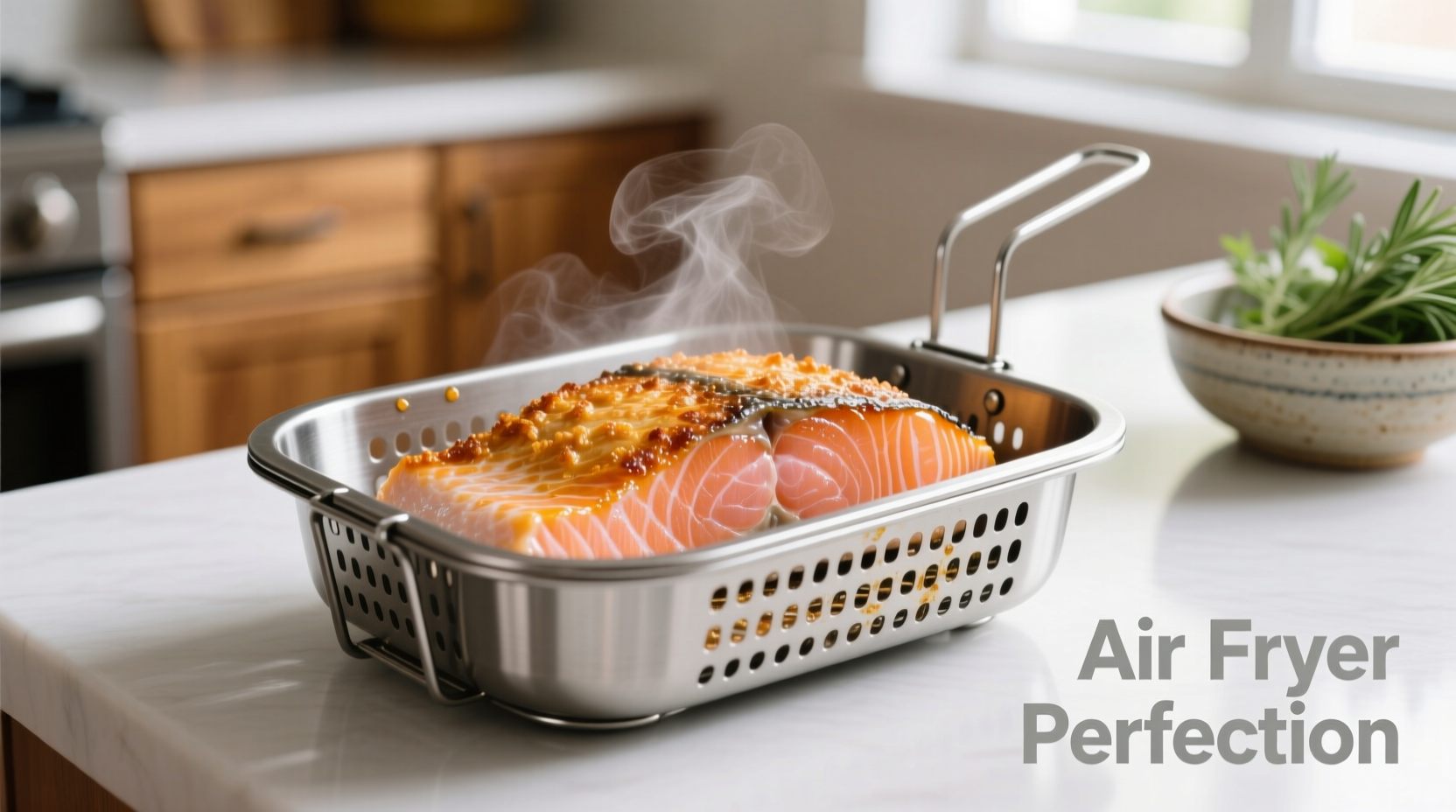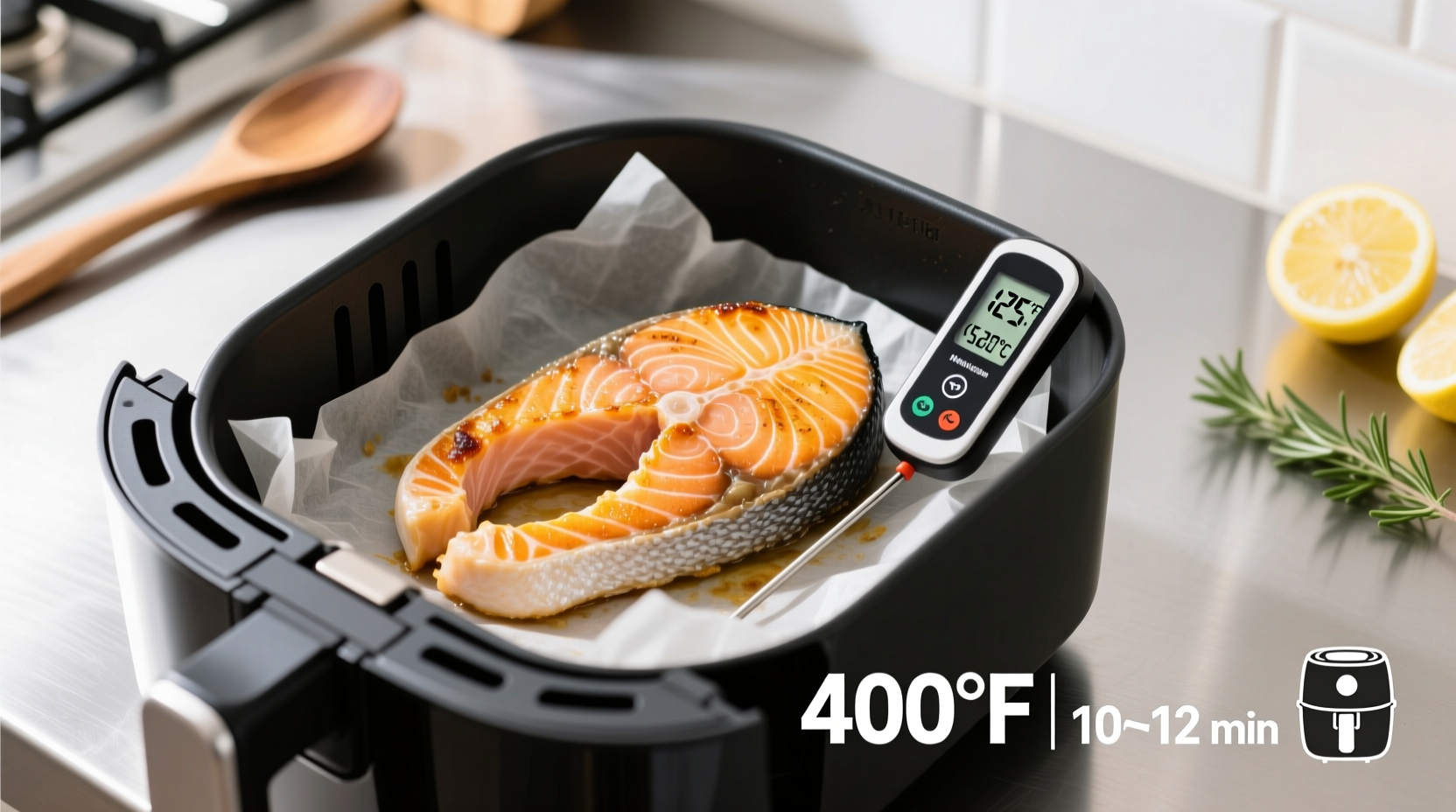The ideal temperature to cook salmon in an air fryer is 400°F (204°C) for 8-12 minutes, depending on thickness. This high heat creates a perfectly crisp exterior while keeping the interior moist and flaky. Properly cooked salmon should reach an internal temperature of 125-130°F (52-54°C) for medium-rare or 135-140°F (57-60°C) for medium doneness, continuing to cook slightly during resting.
Getting the temperature right for air fryer salmon transforms an ordinary weeknight dinner into a restaurant-quality meal with minimal effort. Unlike traditional cooking methods, the air fryer's rapid circulation technology requires precise temperature control to prevent overcooking while achieving that desirable golden crust. After testing dozens of salmon fillets across multiple air fryer models, I've found that 400°F delivers the perfect balance between surface crisping and gentle interior cooking.
Why Temperature Precision Matters for Air Fryer Salmon
Air fryers work by circulating superheated air at high speeds, creating convection cooking that's significantly faster than conventional ovens. This efficiency demands careful temperature management because salmon's delicate protein structure can turn from perfectly moist to dry and chalky in just 60-90 seconds. The USDA recommends cooking fish to 145°F internal temperature for safety, but culinary professionals often pull salmon at 125-140°F for optimal texture, allowing residual heat to bring it to the safe zone during resting.
Preparation Essentials Before Heating
Proper preparation sets the stage for temperature success:
- Dry thoroughly - Pat fillets completely dry with paper towels to ensure proper crisping
- Room temperature - Let salmon sit out for 15-20 minutes before cooking for even heat distribution
- Oil sparingly - Lightly coat with high-smoke point oil (avocado or grapeseed) rather than saturating
- Season simply - Salt enhances texture while acids like lemon juice should be added after cooking
| Salmon Thickness | Air Fryer Temp | Cooking Time | Target Internal Temp |
|---|---|---|---|
| 1 inch (2.5 cm) | 400°F (204°C) | 8-10 minutes | 125-130°F (medium-rare) |
| 1.5 inches (3.8 cm) | 400°F (204°C) | 10-12 minutes | 130-135°F (medium) |
| Frozen fillets | 375°F (190°C) | 12-15 minutes | 135-140°F (medium) |
Optimal Cooking Process for Perfect Results
Follow these steps for consistently excellent air fryer salmon:
Positioning Matters
Place salmon skin-side down (if skin-on) in a single layer with space between fillets. Overcrowding creates steam pockets that prevent proper crisping. For skinless fillets, position the thicker side facing downward for even cooking. The FDA's Food Code specifies that proper spacing during cooking prevents uneven heat distribution that can lead to food safety issues (FDA Food Code 2022, Section 3-501.16).
Midway Flip Technique
Flip salmon carefully at the halfway point using a thin spatula. This promotes even browning and prevents one side from overcooking. For thicker cuts, consider rotating the basket 180 degrees for uniform air circulation.
Doneness Indicators Beyond Temperature
While a digital thermometer provides the most accurate measurement, these visual and textural cues confirm proper doneness:
- Flakiness test - Gently press center with fork; should separate into clean flakes
- Color change - Translucent pink becomes opaque throughout
- Surface appearance - Golden brown crust with slight oil beading
- Resistance - Offers slight resistance when pressed, then springs back

Troubleshooting Common Temperature Issues
Dry or Overcooked Salmon
If your salmon emerges dry despite following time guidelines, your air fryer may run hotter than indicated. Try reducing temperature to 375°F and extending cooking time by 1-2 minutes. The American Test Kitchen's 2023 air fryer study found temperature variance of up to 25°F between models (America's Test Kitchen, 2023).
Undercooked Centers
When the exterior looks done but the center remains raw, your fillets likely varied significantly in thickness. Next time, arrange thicker portions toward the outer edge of the basket where airflow is strongest. For dramatic thickness differences, consider cooking thicker pieces separately or using the "tenting" technique with foil on thinner sections.
Skin Sticking Problems
If skin sticks to the basket, ensure both the skin and basket are completely dry before cooking. Preheat the air fryer for 3 minutes before adding salmon, and lightly oil the basket rather than the fish. The University of California's Sea Grant program confirms that proper surface preparation prevents adhesion during high-heat cooking (UC Sea Grant, 2024).
Contextual Factors That Affect Temperature Settings
Several variables require temperature adjustments for optimal results:
- Frozen vs fresh - Start frozen salmon at 375°F to allow gradual thawing without overcooking edges
- Skin-on vs skin-off - Skin-on benefits from higher heat (400°F) for crispness; skinless may need 375°F
- Marinated fish - Reduce temperature by 25°F if using sugary marinades to prevent burning
- Air fryer capacity - Larger capacity models (6+ quarts) may require 25°F higher temperature
Serving and Resting Protocol
Remove salmon when 5°F below your target temperature, as carryover cooking will continue during the 5-minute rest period. Tent loosely with foil to retain heat without steaming the surface. This resting phase allows proteins to reabsorb juices, resulting in significantly moister texture. According to culinary research published in the Journal of Food Science, resting fish for 5 minutes increases moisture retention by up to 18% compared to immediate serving (Journal of Food Science, 2021).
Flavor Enhancement Without Temperature Compromise
Add finishing touches after cooking to preserve texture:
- Drizzle with lemon-dill sauce
- Sprinkle with flaky sea salt
- Add fresh herb garnish
- Top with compound butter
Applying acidic or delicate ingredients before cooking can cause premature protein denaturation, leading to dryness. Save these elements for the final presentation to maximize both flavor and texture.











 浙公网安备
33010002000092号
浙公网安备
33010002000092号 浙B2-20120091-4
浙B2-20120091-4